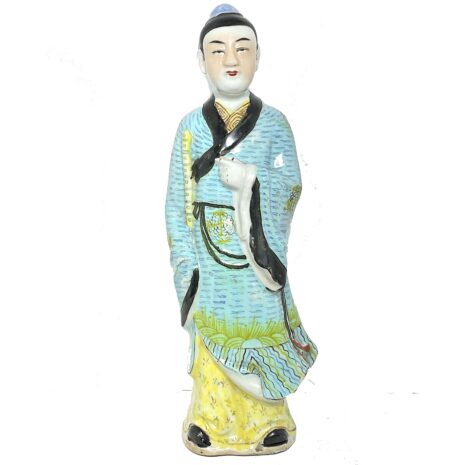SOLD Porcelain Immortal, Chinese Republic, China (17042)
$295.00
H: 12” W: 4.5” D: 3” | FREE SHIPPING WITHIN CONTINENTAL U.S.
This elegant Chinese Republic Period porcelain is the Taoist immortal Han Xiangzi carrying his auspicious flute dressed in a beautiful blue robe with wide black borders, fine internal decorations and a decorative yellow floral undergarment. On the bottom is the kiln seal. As the patron saint of musicians and florists, it is a great gift for someone who enjoys these pursuits.
Description
The Chinese Republic (1912-1949) was established after the downfall of Qing Dynasty and imperial kilns were taken over by private porcelain production complexes that preserved the late Qing quality and integrated Western influences while creating stylistic advances, a colorful aesthetic, and unique shapes and styles. Republic Period and later 20th-century porcelains are recognized for their high quality, clear white finishes, striking new glazes, and unique. designs. This figure is the Taoist Immortal Han-Xiangzi carrying his flute that provides healing sounds and attracts positive energy (chi). He wandered playing his flute with six sweet music sounds that attracts birds, soothes wild beasts and makes flowers bloom and is patron of musicians and florists and thus would make great gifts for them. He was one of the Eight Immortals, the Taoist deities with supernatural powers who perform magic deeds and carry unique identifying objects. He and his flute are auspicious symbols and wishes for good health and happiness. In feng sui Immortals should never be in bathrooms, bedrooms, or kitchens and should face southeast. On the bottom is the impressed kiln seal.
Additional information
| Weight | 5 lbs |
|---|---|
| Dimensions | 14 × 10 × 6 in |
| Place of Origin | China |
| Period | Antique/Vintage Chinese Republic |
| Date | 1912-1949 |
| Materials and Technique | Ceramics |
| Dimensions (inches) | Ht: 12” W: 4.5” D:: 3” |
| Dimensions (metric) | Ht: 30.48cm W: 11.43cm D: 7.62cm |
| Weight | 1 lb 8oz |
| Condition | Excellent, age appropriate signs of wear |
| Item Number | 17042ZRK |
| Shipping Box Size |







